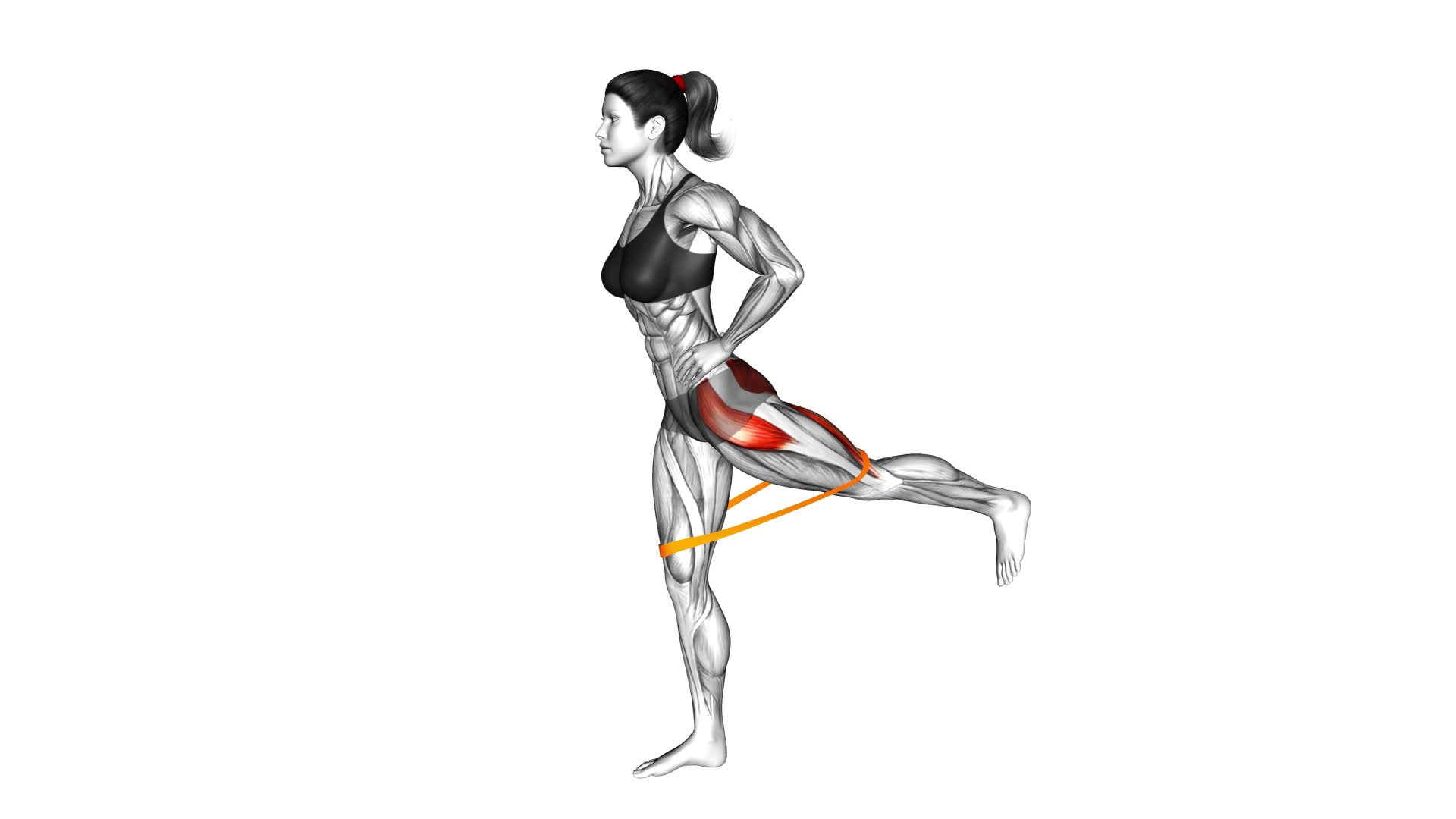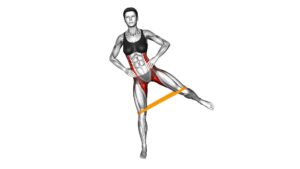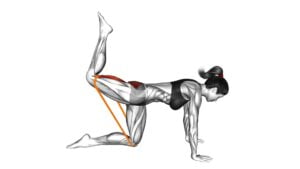Resistance Band Standing Balance Glute Kickback (VERSION 2) (female) – Video Exercise Guide & Tips

Get ready to tone and strengthen your glutes with the Resistance Band Standing Balance Glute Kickback! In this video exercise guide, you'll learn the proper form and technique to target your glute muscles effectively.
Watch This Exercise Video
With progressions and variations to challenge yourself, avoid common mistakes, and maximize the effectiveness of this exercise, you'll be well on your way to sculpting your glutes.
So grab your resistance band, follow along, and get ready to feel the burn!
Key Takeaways
- Resistance band standing balance glute kickbacks effectively target and strengthen the glute muscles.
- Engaging the core and maintaining balance and stability are essential for proper form and technique.
- Progressions and variations such as increasing resistance, modifying foot positioning, and trying different ranges of motion can enhance the effectiveness of the exercise.
- Common mistakes to avoid include rotating hips, neglecting core stability, and maintaining proper form throughout the movement.
Resistance Band Standing Balance Glute Kickback: Benefits
Get the most out of your workout by incorporating the resistance band standing balance glute kickback. This exercise offers numerous benefits for your body, helping you strengthen and tone your glutes while improving your balance.
One of the main benefits of the resistance band standing balance glute kickback is that it targets your glute muscles effectively. By using the resistance band, you add resistance to the movement, making your glute muscles work harder. This can lead to increased muscle strength and improved muscle tone over time.
Another benefit of this exercise is that it helps improve your balance. The standing position forces you to engage your core muscles and stabilize yourself throughout the movement. This not only strengthens your core, but also enhances your overall balance and stability.
To reap the full benefits of the resistance band standing balance glute kickback, it's important to maintain proper form. Start by standing tall with your feet shoulder-width apart, and place the resistance band just above your ankles. Keep your core engaged and your back straight throughout the exercise. As you kick your leg back, focus on squeezing your glutes to activate the muscles effectively.
Incorporating the resistance band standing balance glute kickback into your workout routine can help you achieve stronger and more toned glutes, while also enhancing your balance and stability. Remember to maintain proper form to maximize the benefits of this exercise.
Proper Form and Technique for Resistance Band Standing Balance Glute Kickback
To perform the resistance band standing balance glute kickback with proper form and technique, you should start by standing tall with your feet shoulder-width apart and the resistance band positioned just above your ankles. Here's how you can ensure proper alignment and muscle activation:
- Engage your core: Draw your belly button in towards your spine to activate your deep core muscles. This will help stabilize your pelvis and maintain proper alignment throughout the exercise.
- Balance on one leg: Shift your weight onto one leg while keeping a slight bend in your knee. This will challenge your balance and activate your glute muscles even more.
- Keep a neutral spine: Avoid arching or rounding your lower back. Instead, maintain a neutral spine by gently tucking your tailbone under and lengthening through the crown of your head.
- Kick back with control: Slowly extend your free leg straight back while keeping your hips squared and facing forward. Focus on squeezing your glutes at the top of the movement before returning to the starting position.
Progressions and Variations for Resistance Band Standing Balance Glute Kickback
Now let's explore some progressions and variations for the resistance band standing balance glute kickback exercise.
One option to increase resistance is to use a stronger resistance band or add multiple bands for a greater challenge.
Additionally, you can modify your foot positioning by placing the band around your ankle or above your knee to target different muscles in your glutes and legs.
Experimenting with these variations can help you continue to challenge and strengthen your glutes during this exercise.
Increased Resistance Options
To increase the resistance for the Resistance Band Standing Balance Glute Kickback exercise, you can try using heavier resistance bands or adding ankle weights for a more challenging workout. Here are some options to help you increase the resistance and make the most out of your glute kickback routine:
- Use heavier resistance bands: Opt for bands with higher resistance levels to provide more tension and challenge your glutes even further.
- Add ankle weights: Attach ankle weights to your ankles to increase the load on your glutes, making the exercise more intense.
- Modify foot positioning: Experiment with different foot positions, such as pointing your toes or turning them out slightly, to target different areas of your glutes.
- Increase the range of motion: Gradually work towards extending your leg further back during the kickback, increasing the resistance on your glutes.
Modified Foot Positioning
Try experimenting with different foot positions to target different areas of your glutes during the Resistance Band Standing Balance Glute Kickback exercise. Modifying your foot position can help increase glute activation and enhance the effectiveness of the exercise.
To focus on your gluteus maximus, place your foot slightly behind your body's midline. This will engage the larger muscle fibers in your glutes.
For more emphasis on the gluteus medius, position your foot slightly across your body's midline. This will target the smaller muscle fibers on the side of your glutes.
Additionally, you can try turning your toes inward or outward to activate different parts of your glutes.
Common Mistakes to Avoid During Resistance Band Standing Balance Glute Kickback
When performing the resistance band standing balance glute kickback, it's important to maintain proper form to maximize the effectiveness of the exercise.
One common mistake to avoid is rotating your hips during the movement, as this can shift the focus away from the glutes.
Additionally, focusing on core stability by engaging your abdominal muscles can help you maintain balance and control throughout the exercise.
Proper Form Importance
Maintain proper form to avoid common mistakes during the resistance band standing balance glute kickback exercise. Proper form is crucial for maximizing the benefits of this exercise and preventing injury. Here are some important points to keep in mind:
- Balance is key: Engage your core and keep your body centered to maintain balance throughout the movement. This will ensure that you target the glutes effectively.
- Activate your glutes: Before starting the kickback, focus on activating your glutes by squeezing them together. This will help you engage the right muscles and get the most out of the exercise.
- Keep a neutral spine: Avoid arching your back or hunching your shoulders. Maintain a neutral spine throughout the movement to protect your lower back and maintain proper alignment.
- Control the movement: Avoid swinging your leg or using momentum to lift it. Instead, focus on using your glutes to lift and extend your leg behind you, maintaining control throughout the entire range of motion.
Avoiding Hip Rotation
To avoid hip rotation during the resistance band standing balance glute kickback exercise, ensure that you keep your hips stable and aligned throughout the movement. This is crucial for avoiding hip injuries and effectively strengthening your glute muscles.
When performing the exercise, focus on maintaining a neutral spine and engaging your core to stabilize your hips. Avoid allowing your hips to sway or rotate as you lift your leg backward.
Keep your standing leg slightly bent and your weight centered over your foot to maintain balance and stability. By consciously controlling your hip movement and maintaining stability, you can prevent any unwanted rotation and achieve maximum benefits from the exercise.
Core Stability Tips
To ensure proper core stability during the resistance band standing balance glute kickback exercise, focus on engaging your abdominal muscles. This will help you maintain balance and control throughout the movement. Here are some tips to maximize the effectiveness of your core stability:
- Keep your core tight: Activate your abdominal muscles by pulling your belly button towards your spine. This will create a stable base for the exercise.
- Maintain a neutral spine: Avoid arching or rounding your back. Keep your spine aligned and lengthened throughout the movement.
- Breathe properly: Remember to breathe steadily and deeply. Inhale during the initial phase and exhale as you kick your leg back.
- Control your movements: Slow and controlled movements will engage your core muscles more effectively. Avoid swinging or using momentum.
Tips for Maximizing the Effectiveness of Resistance Band Standing Balance Glute Kickback
How can you enhance the effectiveness of your resistance band standing balance glute kickbacks? Maximizing balance and glute activation are key to getting the most out of this exercise.
To maximize balance, make sure you have a stable and firm surface to stand on. This will allow you to focus on engaging your glutes without worrying about losing your balance. Additionally, keep your core engaged and maintain a strong posture throughout the exercise. This will help you stay stable and prevent any unnecessary movement.
To maximize glute activation, focus on squeezing your glutes at the top of each kickback. This will ensure that you're effectively targeting and activating the glute muscles. You can also try using a heavier resistance band or increasing the tension of the band to challenge your glutes even more.
Remember to start with a proper warm-up before performing the resistance band standing balance glute kickbacks. This will help prepare your muscles for the workout and reduce the risk of injury.
By incorporating these tips, you can enhance the effectiveness of your resistance band standing balance glute kickbacks and achieve better results in your glute training.
Now, let's move on to a sample workout routine that incorporates the resistance band standing balance glute kickback.
Sample Workout Routine Incorporating Resistance Band Standing Balance Glute Kickback
To incorporate the resistance band standing balance glute kickback into your workout routine, begin by securing the resistance band around your ankles. This exercise specifically targets the glute muscles and can be modified to suit your fitness level.
Here is a sample workout routine that incorporates the resistance band standing balance glute kickback:
- Warm up: Start with a five-minute dynamic warm-up, such as jogging or jumping jacks, to get your muscles ready for the workout.
- Resistance band activation: Perform 10-15 reps of resistance band side steps to activate your glutes and prepare them for the kickback exercise.
- Resistance band standing balance glute kickback: Stand tall with your feet hip-width apart and your hands on your hips. Lift one leg straight back while keeping your knee slightly bent. Squeeze your glutes at the top of the movement and then slowly return to the starting position. Complete 12-15 reps on each leg.
- Repeat: Repeat the resistance band standing balance glute kickback exercise for a total of 2-3 sets, resting for 30-60 seconds between sets.
Remember to listen to your body and adjust the resistance band tension as needed. As you progress, you can increase the number of sets or reps to challenge your glute muscles even more.
Frequently Asked Questions
What Are Some Alternative Exercises That Target the Same Muscle Group as the Resistance Band Standing Balance Glute Kickback?
Looking for alternative exercises that target the same muscle group as the resistance band standing balance glute kickback?
There are a few options you can try. Consider incorporating exercises like lunges, step-ups, or hip thrusts into your routine.
These exercises engage the glutes and can help strengthen and tone the same muscle group as the glute kickback.
Remember to focus on proper form and gradually increase the intensity as you progress.
How Long Should I Hold Each Glute Kickback Repetition for Maximum Results?
To maximize results, hold each glute kickback repetition for at least 1-2 seconds at the top of the movement. This will ensure that you fully engage and activate your glute muscles. As you progress, you can increase the hold time to challenge your muscles even more.
Incorporating glute kickbacks into your workout routine offers numerous benefits. One of these benefits is improved glute strength. By targeting and working the glute muscles, you can enhance their strength and definition.
Another benefit of glute kickbacks is increased hip stability. The glute muscles play a crucial role in stabilizing the hips, and by strengthening them, you can improve your overall hip stability. This can be particularly beneficial for athletes or individuals who engage in activities that require a stable lower body.
Additionally, glute kickbacks contribute to enhanced overall lower body strength. By engaging the glute muscles, you are also working other muscles in the lower body, such as the hamstrings and quadriceps. This compound movement helps to strengthen and tone these muscles, leading to improved lower body strength.
Can I Perform the Resistance Band Standing Balance Glute Kickback Without Using a Resistance Band?
Yes, you can perform the resistance band standing balance glute kickback without using a resistance band. However, using a resistance band adds extra resistance and helps to target and engage your glute muscles more effectively.
It also helps to improve balance and stability during the exercise.
If you don't have a resistance band, you can try alternative exercises like donkey kicks or fire hydrants to target your glutes.
How Many Times a Week Should I Include the Resistance Band Standing Balance Glute Kickback in My Workout Routine?
To effectively incorporate the resistance band standing balance glute kickback into your workout routine, consider how often you should perform it. The frequency will depend on your overall fitness goals and the intensity of your other workouts.
Aim to include this exercise 2-3 times a week to properly engage and strengthen your glute muscles. Remember, there are different variations of this exercise, so you can mix it up and challenge your muscles in various ways.
Is It Normal to Feel Soreness in Other Parts of the Body After Performing the Resistance Band Standing Balance Glute Kickback?
Feeling soreness in other parts of your body after doing the resistance band standing balance glute kickback is normal. It could be because your body is adjusting to the exercise and engaging different muscles to maintain balance.
To minimize this, focus on maintaining proper form throughout the movement. As you progress, you can increase the difficulty by using a heavier resistance band or adding ankle weights.
Conclusion
In conclusion, the resistance band standing balance glute kickback is an effective exercise for targeting and strengthening the glute muscles. By maintaining proper form and technique, avoiding common mistakes, and incorporating progressions and variations, you can maximize the effectiveness of this exercise.
Adding it to your workout routine can help improve balance, stability, and overall lower body strength. So grab your resistance band and start kicking those glutes into shape!

Author
Years ago, the spark of my life’s passion ignited in my mind the moment I stepped into the local gym for the first time. The inaugural bead of perspiration, the initial endeavor, the very first surge of endorphins, and a sense of pride that washed over me post-workout marked the beginning of my deep-seated interest in strength sports, fitness, and sports nutrition. This very curiosity blossomed rapidly into a profound fascination, propelling me to earn a Master’s degree in Physical Education from the Academy of Physical Education in Krakow, followed by a Sports Manager diploma from the Jagiellonian University. My journey of growth led me to gain more specialized qualifications, such as being a certified personal trainer with a focus on sports dietetics, a lifeguard, and an instructor for wellness and corrective gymnastics. Theoretical knowledge paired seamlessly with practical experience, reinforcing my belief that the transformation of individuals under my guidance was also a reflection of my personal growth. This belief holds true even today. Each day, I strive to push the boundaries and explore new realms. These realms gently elevate me to greater heights. The unique combination of passion for my field and the continuous quest for growth fuels my drive to break new ground.







